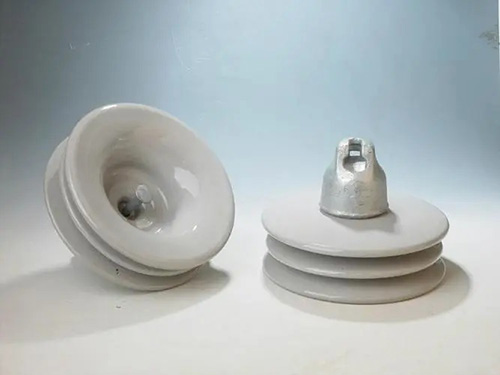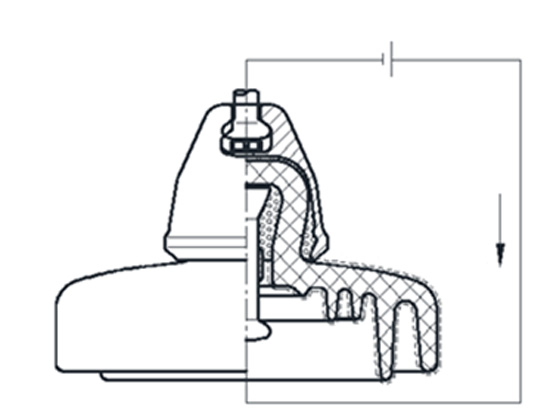Among the electrical insulators used in overhead lines, porcelain insulators still occupy 1/3 share. It often appears in the operation of the defective fault including zero value, broken string, rust, etc. Once the above problems occur will seriously affect the line safety, today to talk about the causes of the above problems and countermeasures.

1. zero value and broken string
1.1 Porcelain insulator broke string mechanism
For porcelain insulators, when the insulator head porcelain parts have defects such as fine cracks, with the intrusion of moisture in operation, the insulator head insulation resistance is reduced (the formation of zero value insulators). Once the insulator string suffers a lightning strike or flashover caused by other reasons, the resistance is relatively large due to the minimal head resistance and the long discharge distance along with the umbrella disk. Therefore, most of the energy is discharged from the discharge channel at the head of the porcelain insulator, and the heat generated when the arc passes from the insulator head makes the insulator blow up and produce a broken string.
1.2 Zero-value defect causes
① Bad insulator quality
The porcelain insulator’s poor gluing interface process and poor material of porcelain parts will lead to the generation of zero value insulators.
The porcelain insulator gluing interface exists in porcelain, cement, steel, and other materials with different thermal expansion coefficients. Generally, materials such as asphalt need to be coated as a buffer layer. When the buffer layer is too thin or not enough to fit with porcelain, cement, and other materials, the insulator withstands external temperature changes leading to interface cracking.
The presence of sand eyes in the porcelain insulator porcelain parts, or the size of the porcelain grains is too large, and micro-cracks are generated inside the porcelain parts during long-term operation, and the cracks expand to a certain extent leading to the generation of low zero value insulators.
② Multiple lightning strikes
When a tower is struck by lightning, the insulator may be subjected to a high impact voltage of steepness and amplitude. At this time, the highest voltage (porcelain head), the relative weakness of the insulation may produce partial discharge damage. When subjected to repeated steep wave impact, the damage to the insulator’s porcelain head will gradually expand to a certain extent, leading to the formation of low-value insulators.
③ Excessive mechanical load
Severe ice cover and high winds beyond the design wind speed cause insulators to be subjected to excessive mechanical stress, which may lead to cracking of insulators at the steel foot position, resulting in low zero value insulators.
Most of the early porcelain insulators’ zero value is caused by their material. As the technical level of porcelain insulators improved, the corresponding quantity was relatively reduced. And with the increase of porcelain insulator operation years, the situation of multiple lightning strikes causing zero value needs to be paid attention to.
1.3 Countermeasures
① Strengthening zero value detection
Zero value detection workload, detection efficiency, and detection methods are closely related to the difficulty of the operation of charged measurement on the tower, which is still not a completely solved problem. Under the existing technology, the following means can be used to improve the zero value detection efficiency.
A. To carry out sampling inspection of porcelain insulators in multi-mine areas, replace a portion of insulators to the laboratory for sampling and testing. Conduct insulation resistance test when air humidity is high (some low-value insulators are difficult to be measured when dry) and carry out steep wave impact test. Check whether there is any damage to the head of the porcelain parts.
B. Increase the insulation resistance test voltage.
② Adopt sparse lightning protection measures
Adopt diversion-type lightning protection measures such as parallel gaps and lightning arrestors to avoid lightning current flowing through insulators to reduce the probability of insulator damage.
③ Enhance the lightning resistance level of the line
Modify grounding, strengthen insulation, and try to limit the magnitude of impact voltage that insulators bear after being struck by lightning.
2. Fixture corrosion
2.1 Corrosion mechanism
(1) Corrosion of DC insulator fixtures
Domestic UHV DC and ±500kV DC transmission line disk-type suspension insulators have all experienced steel cap and steel foot corrosion, steel cap corrosion is concentrated in the steel cap mouth, steel foot corrosion is concentrated in the steel foot, and cement contact. The products of steel cap corrosion often adhere to the insulating disc with rainwater, causing an increase in the equivalent salt density on the surface of the disc and bringing the risk of fouling and flashing. Steel foot corrosion will cause steel foot diameter reduction, resulting in mechanical damage load reduction. In addition, the steel foot inside the glue binding corrodes and expands in volume, causing the glue binding to fail.
Steel cap corrosion products attached to the umbrella plate
The steel foot and steel cap corrosion of DC insulators originate from the anodic corrosion produced by electrolytic corrosion. Under the action of DC power supply electric potential, the metal electrode connected to the positive pole of the power supply loses electrons and becomes a cation to leave the material surface, forming anodic corrosion.
Electrolytic corrosion – anodic corrosion
When the insulator surface is wet, the steel foot and steel cap are equivalent to a pair of electrodes, the water film on the surface of the umbrella disc is equivalent to the electrolyte, and the leakage current flowing through will continue to produce the electrolytic process.
When the wire is positive polarity, the potential of the steel foot side is higher, and corrosion is generated at the junction of the steel foot and the cement surface (i.e., at the zinc jacket, which is equivalent to the contact position of the positive electrode and the electrolyte).
When the wire is negative polarity, the potential of the iron cap side is higher, corrosion occurs at the mouth of the iron cap (here is equivalent to the positive electrode and electrolyte contact position).
DC insulator steel foot is equipped with a zinc sleeve, a steel cap is equipped with a zinc ring, zinc is more active than steel, zinc sleeve, zinc ring priority to corrosion. When the zinc sleeve and zinc ring are missing, or the zinc sleeve and zinc ring are lost on one side, the steel foot and steel cap will be corroded rapidly.

(2) Corrosion of AC insulator fixtures
The electrolytic corrosion effect on the surface of the AC line insulator is weak, and the rusting of the steel foot and steel cap generally originates from the overall oxidation. After the loss of galvanized layer on the surface in long-term operation, the internal steel starts to rust, generally presenting the overall discoloration of steel feet and caps.
The rusting of the steel cap will affect the surface dirtiness of the umbrella plate, the rusting of the steel foot will affect the mechanical strength, and the rusting of the steel foot is more serious harm.
2.2 Countermeasures
For DC insulators, it should be ensured that the steel foot has a zinc sleeve and the steel cap has a zinc ring.
Early DC insulator steel cap without zinc ring can be used to prevent corrosion by replacing the zinc ring. According to the analysis of corrosion location above, the zinc ring should be installed at the mouth of the cap where the steel cap is in contact with the insulating umbrella.
The national standard GB/T19443-2004 stipulates that the zinc sleeve should be made of zinc with a purity of not less than 99.8%. The fused area is not less than 80% of the articulated part of the ring cap, the weight of the zinc sleeve should be at least 5 g, and the exposed size is about 50% of the total length. There is no promulgated standard for zinc rings, but the corresponding provisions have been made in the current technical specification book for ±1100 kV UHV DC insulators, which generally require a maximum thickness of at least 6 mm and a mass of at least 150 g.
For AC insulators, when steel cap corrosion and zinc layer damage are found, the steel foot should be inspected and replaced as soon as possible if the corrosion has occurred. If only the steel cap is corroded, the operation can be continued, but monitoring should be strengthened to prevent the occurrence of surface fouling.
3. Summary
① The key to the broken string of the porcelain insulator is that the insulator has produced zero value defects. The causes of the low zero value of porcelain insulators include poor quality, suffering from multiple lightning overvoltage shocks, and excessive external mechanical stress.
② For porcelain insulators with low zero value problems, targeted measures include strengthening low zero value detection, adopting diversionary lightning protection measures, and improving line lightning resistance levels.
③ The corrosion of steel feet and steel caps of DC insulators originates from the anodic corrosion produced by electrolytic corrosion, and the wetted layer on the surface of the umbrella disc is equivalent to the electrolyte. The corrosion of the steel cap is concentrated in the mouth of the steel cap, and the corrosion of the steel foot is concentrated in the contact between the steel foot and cement. The corrosion of steel foot and steel cap of AC insulator generally originates from oxidation after long-term operation.
④ DC insulator steel foot should have zinc sleeve, steel cap should have zinc ring, AC insulator steel foot should be replaced as soon as possible once corroded.
